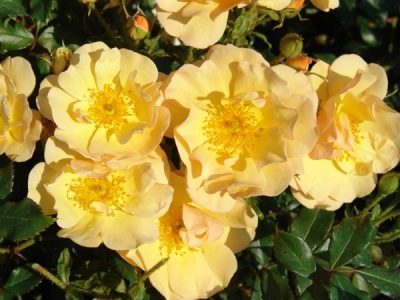
- Authors: W. Kordes' Söhne
- Name synonyms: Amber Sun
- Breeding year: 2005
- Group: ground cover
- The main color of the flower: yellow
- Flower size: medium
- Diameter, cm: 5
- Flower type by number of petals: semi-double
- Description of the bush: vigorous, compact
- Bush height, cm: 50
Low-growing varieties of roses are in high demand among summer residents and landscape designers. This is due to the fact that compact flowering bushes look great in single and group plantings, without requiring complex care. These include the pink variety Amber San of German selection.
Breeding history of the variety
Rose Amber Sun ("amber sun") is a relatively new variety, developed by German scientists in 2005. The variety belongs to the class of ground cover. Authorship belongs to W. Kordes Sohne. The flower bush is cultivated in different regions of Russia and Ukraine.
Description of the variety
Amber Sun is a compact shrub that grows up to 50-60 cm in height. The plant is characterized by upright strong shoots, abundant thickening of medium-sized dark green leaves with a pronounced gloss, as well as a developed root system. The stems of the bush contain few elongated thorns, which makes it easier to care for and cut flowers. During the growing season, the bush grows strongly in width, reaching a diameter of 50-60 cm. Inflorescences with 5-8 flowers are formed on each stem.
Advantages and disadvantages
This variety attracts not only with the beauty of the flowers, but also with many other advantages: frost resistance, abundant intensity of continuous flowering, good immunity that protects against fungal infections, as well as excellent resistance to rain, due to which the flowers do not fade.
Among the shortcomings, it is worth noting the burning of the petals in the sun, as well as the weak intensity of the aroma.
Flowering features
The German rose represents a class of richly flowering varieties. The flowering period begins in June and lasts until the frost. The buds, collected in inflorescence brushes, bloom alternately. Semi-double flowers in a medium-sized variety: the diameter is 4-5 cm. The structure of the flower is multilayer, consisting of 15-20 petals. They are remembered for their unusual color: from copper-yellow to creamy yellow.
The petals are bright enough with wavy edges. Very often, fully blooming cupped roses become creamy, with a golden tint. The blossoming buds are not only pleasing to the eye, but also beckon with a light floral scent with subtle fruity notes.
Use in landscape design
Amber Sun roses have a wide range of uses. Rose bushes are planted singly in flower beds, as well as in containers so that they can be transferred, in mixborders, near curbs. In addition, Amber Sun goes well with burgundy, purple, dark blue, deep pink floral arrangements. With the help of bright roses, flower beds, front gardens are decorated, areas are zoned.
Landing
To plant a rose, you will need quality seedlings with a healthy root system. On the site, pits are prepared with a depth of 40-60 cm, where drainage from gravel or crushed stone is laid, then fertilizers are applied (layer about 10 cm). 4-5 seedlings are placed per 1 m2. After planting, the beds are watered abundantly with warm water, the soil is compacted.
Growing and caring
Rose bushes are planted from April to May, when stable heat comes, the soil warms up enough. For planting, choose the southern part of the flower bed, where it is light and warm throughout the day. The plant needs 3-4 hours of abundant sunlight daily.Bushes are capable of growing even in partial shade, in which the color of the roses will be more saturated, but the amount will be smaller.
Roses grow comfortably in light, fluffy, nutrient-rich soils. The soil should be good for moisture and air permeability, and also have a neutral acidity index. Nutritious chernozems or light loams will be optimal. Experienced growers recommend planting pink bushes in low elevations.
Plant care consists of standard procedures: watering, careful weeding and loosening of the soil, fertilizing, sanitary pruning of bushes, prevention of viruses and pest infestations, and shelter for the winter.
Watering and feeding
Water the rose several times a week in small portions: 5-8 liters of settled or warm water is introduced slowly and at the root. In too dry periods, evening irrigation is additionally carried out. The German rose needs feeding. Liquid and solid fertilizers are applied every 2 weeks.
Pruning
The flower needs regular seasonal pruning in early spring, summer and late fall. Frozen shoots are removed in spring, and twigs are shortened slightly. In the summer, it is necessary to cut off wilted buds. Before winter, sanitary pruning is carried out, in which damaged and diseased branches are cut off, partial thinning of the bushes is carried out.
Frost resistance and preparation for winter
In regions with severe and little snowy winters, rose bushes need shelter. For this, film or agrofibre is used. In a warm winter, mulching from spruce branches is enough.
Diseases and pests
Strong immunity of the crop provides resistance to many diseases, for example, powdery mildew and brown spot. Pests rarely attack rose bushes.































































